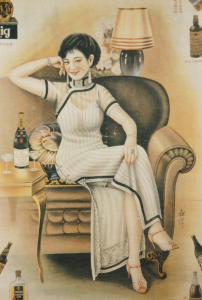These three images were found in Professor Tsui slide show presentation. By displaying them together we can start to understand the transition from the traditional robe, to the qipao, to the westernized qipao. In the first picture we see cixi empress Dowager of china in a traditional Manchu robe, also in platform shoes, indicative of a Manchu women who wanted to emulate aspects of the bound foot. These traditional robes were loose, had baggy sleeves and were long. As time progressed and western fashion influence was brought forward through the port at shanghai there started to emerge the original qipao. The qipao had a high collar, slits, and knot buttons. As seen in the middle picture of the qipao, they resulted in a more sexualized view of the entire female body as compared to just the feet in earlier times. The qipao displayed in this picture is see-through, not the case for all qipao at the time, however this further sexualized the garment. The qipao was shown to the western world through calendars, ads and movies. Westerners were intrigued by the design and emulated it in their high fashion runways. We see in the 3rd picture a white woman wearing a qipao looking dress. The dress she is wearing has the same high neck and buttons of the qipao but its bright colors and pattern relate more to the 70s fashion style of the time. The Qipao has greatly changed over time and shows china’s connection to west through its transitions. Now matter what, the qipao is a beautiful garment that shows the great
culture of china.



the idea of transition sounds, but the question of how the transition is made in terms of qipao denotations are not sufficient, persuasive enough.
